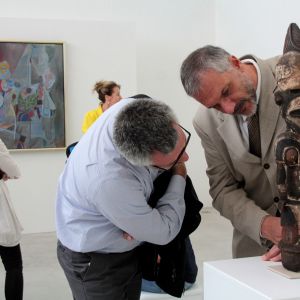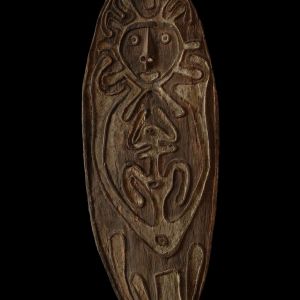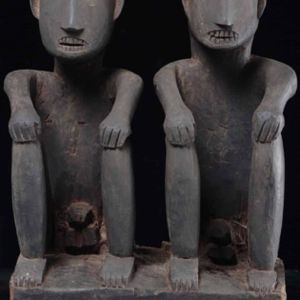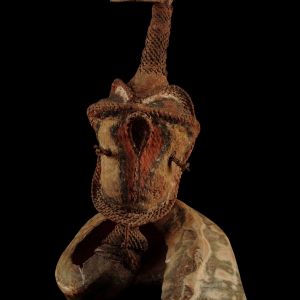HELENEUM LUGANO E M.A.X. MUSEO, CHIASSO
The exhibition celebrates the 110th anniversary of Brignoni’s birth. It is the result of a collaboration between the m.a.x. museum in Chiasso and the MUSEC in Lugano and presents to the public around one hundred works from some of the most important museums, public institutions, galleries and collectors throughout Switzerland. The exhibition highlights not only Brignoni’s passion for collecting, but also his being an all-round artist: painter, sculptor as well as graphic artist. On display at the m.a.x. museum are some 100 works created by Brignoni between 1920 and 2000, ranging from collage to lithography, from watercolour to painting, from woodcut to gouache, from bas-relief to iron sculpture. With the ambitious intention of showing Brignoni’s most significant artistic research, his works are put in dialogue with twenty-six masterpieces from his collection of ethnic art, now part of the MUSEC heritage. This is an integrated exhibition project where the public will be able to get closer to Brignoni’s universe, which includes both his passion for ethnic art and his personal artistic journey. In fact, if the m.a.x. museum will host works from the collection – including the mask-masks from Oceania and Africa and decorated pillars from Melanesia – the Museo delle Culture will also present fifteen paintings by Brignoni from the collection of Marlyse Haller Brignoni, in a true reflection between inspiration and creation.
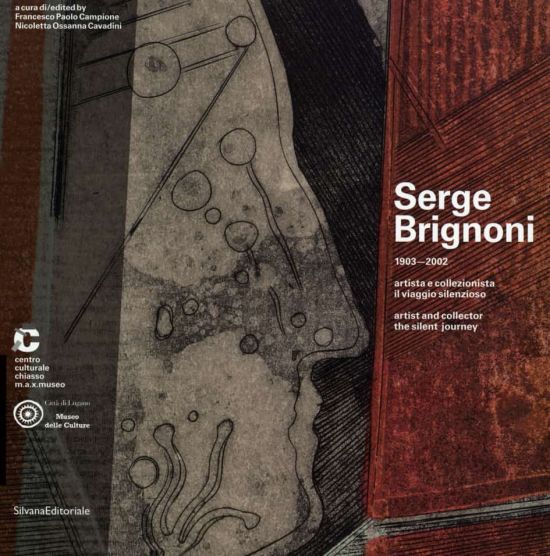
The graphics of Serge Brignoni
Scarcely studied in the field of engraving technique, although his research reached high levels, only about thirty graphic works by the artist can be seen. Brignoni approached graphic art in his early twenties, in 1922, working with engraver Hans Meid. Landscapes, portraits and interior scenes are the themes of his first copperplate engravings. In the Parisian period until the 1950s, drawing on surrealism, he depicted circles, spirals and original forms of nature, ranging from dry point to etching, from woodcut to lithography. Also, on show are his copper and zinc woodcut plates with related prints of artist’s proofs.
The Sculpture of Serge Brignoni
Of the two hundred sculptures created by Brignoni between 1927 and 1940 and after 1950, on display at the m.a.x. museum are a dozen chosen chronologically. In every artistic creation, formal problems are questions of space to be resolved on a three-dimensional plane; hence the Swiss artist’s self-consciousness that, in his production, accentuates the sense of openness that takes possession of space. The materials used in the creation of sculptures are wood, iron, bronze, copper and some synthetic materials. Of particular note is the sculpture Female Figure with Child of 1933, considered to be the first iron sculpture of an abstract nature in Switzerland.
The painter and collector Serge Brignoni
Born in Vacallo on 12 October 1903, he belonged to the avant-garde movement of the 20th century, fascinated since his youth by the surrealism of André Breton and Tristan Tzara, a close friend of Alberto Giacometti with whom he shared a flat in Paris. Exhibiting at Odette Luce (later to become Pétrides) in 1926 with a solo exhibition together with Joan Mirò, a friend of Georges Braque and Pablo Picasso, fascinated by Matisse and De Chirico, Brignoni crosses the various artistic moments from the 1930s to 2000. From a young age, Serge Brignoni became fascinated by what was then called ‘primitive art’, of which he became a collector of high standing, purchasing works that were later donated to the City of Lugano and are now preserved at MUSEC. Thanks to surrealism, he became particularly interested in objects from Oceania, which, according to this artistic current, embodied the spiritual side of creation and the manifestation of all desire. The impulse of trade in the 1930s brought objects from all over the world to European markets. Collector Brignoni conducted business in Germany, Belgium and Holland. From 1946, he devoted himself to researching works and collections of ethnic art. Counted among the most important in Switzerland, his collection boasts numerous rare works. Highlights of the exhibition include: a series of talipun moneta-masks from Sepik used in ceremonial settings; a blontang pole from Borneo carved in ironwood and probably depicting a dignitary; a pair of gope tablets from the Gulf of Papua, both depicting a guardian spirit; and an uli sculpture from New Ireland, with an androgynous nature, belonging to a particular type of work to which André Breton dedicated a poem. From Switzerland to Berlin and Paris, and back again, Serge Brignoni died in Berne on 6 January 2002 at the age of 99.


